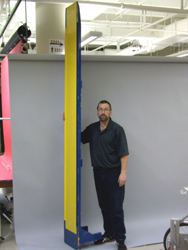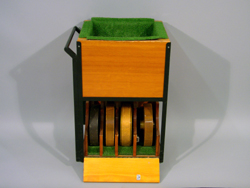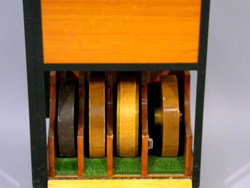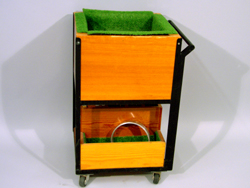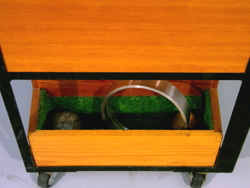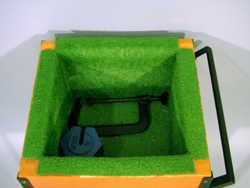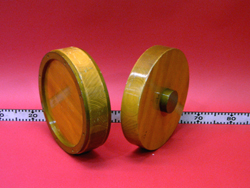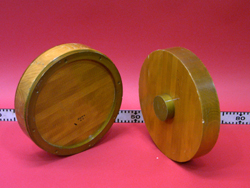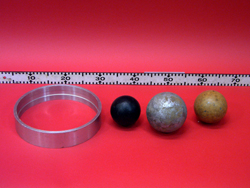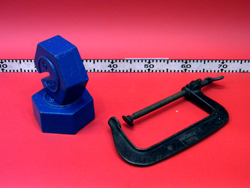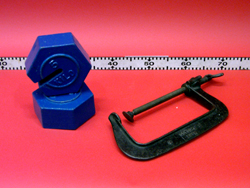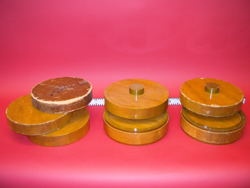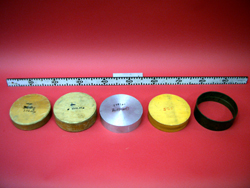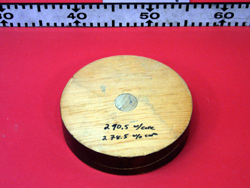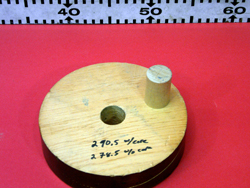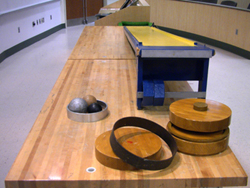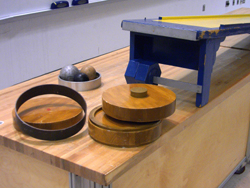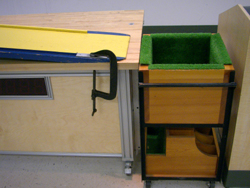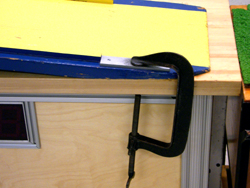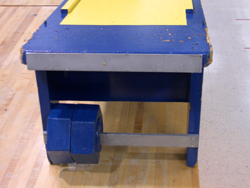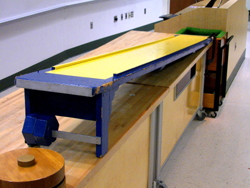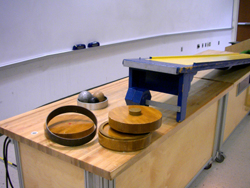|
Size: 2666
Comment:
|
← Revision 14 as of 2018-07-18 17:21:15 ⇥
Size: 4761
Comment:
|
| Deletions are marked like this. | Additions are marked like this. |
| Line 2: | Line 2: |
| ||<:30%>[:PiraScheme#Mechanics: Table of Mechanics Demonstration]||<:30%>[:MEEquipmentList: List of Mechanics Equipment & Supplies]||<:30%>[:Demonstrations:Lecture Demonstrations]|| | ||<30% style="text-align:center">[[PiraScheme#Mechanics|Table of Mechanics Demonstration]] ||<30% style="text-align:center">[[MEEquipmentList|List of Mechanics Equipment & Supplies]] ||<30% style="text-align:center">[[Demonstrations|Lecture Demonstrations]] || |
| Line 5: | Line 6: |
| '''Topic and Concept:''' | |
| Line 6: | Line 8: |
| '''Topic and Concept:''' Rotational Dynamics, [:RotationalDynamics#MomentOfInertia: 1Q10. Moment of Inertia] |
. Rotational Dynamics, [[RotationalDynamics#MomentOfInertia|1Q10. Moment of Inertia]] '''pira200 Listed''' |
| Line 10: | Line 13: |
| * [:MechanicsCabinet#MEFloorItems: ME South Wall] | |
| Line 12: | Line 14: |
| attachment:RingDiscSphere19-400.jpg | * [[MechanicsCabinet#MEFloorItems|ME South Wall]] {{attachment:RingDiscSphere19-400.jpg}} |
| Line 17: | Line 21: |
||<:style="width: 60%" :40%>'''Equipment'''||<:30%>'''Location'''||<:25%>'''ID Number'''|| |
||<40% style="" ;text-align:center">'''Equipment''' ||<30% style="text-align:center">'''Location''' ||<25% style="text-align:center">'''ID Number''' || |
| Line 20: | Line 23: |
| ||Cart w/ Ring, Disc, & Sphere||[:MechanicsCabinet#MEFloorItems: Floor Item: ME South Wall]|| || ||Inclined Plane||[:MechanicsCabinet#MEFloorItems: Floor Item: ME South Wall]|| || ||Ring, Disc, & Sphere Extras||[:MechanicsCabinetBayB9: ME, Bay B9, Shelf #3] or in Cart|| || '''''Important Setup Notes:''''' * N/A |
||Cart w/ Ring, Disc, & Sphere ||[[MechanicsCabinet#MEFloorItems|Floor Item: ME South Wall]] || || ||Inclined Plane ||[[MechanicsCabinet#MEFloorItems|Floor Item: ME South Wall]] || || ||Ring, Disc, & Sphere Extras ||[[MechanicsCabinetBayB9|ME, Bay B9, Shelf #3]] or in Cart || || ||Table DMM-Timer ||[[Table_DMM-Timer|Lecture Bench]] || || |
| Line 28: | Line 29: |
| '''Setup and Procedure:''' | |
| Line 30: | Line 30: |
| 1. List steps for setup then procedure. 1. ... |
'''''Important Setup Notes:''''' * N/A '''Setup and Procedure:''' 1. Unload the ring, disc, and spheres from the cart. 1. Position the cart at the stage right end of the lecture bench so that it is touching the bench (see pictures). 1. Place the ramp on top of the lecture bench so that it is in line with the cart and such that the bottom edge of the ramp is within about 2 inches of the cart. 1. Secure the bottom of the ramp to the bench using the C-clamp provided in the cart. 1. Use the provided weights to hold down the top end of the bench (see pictures). 1. Either roll each object down individually or in pairs to directly compare descent times. A [[Table_DMM-Timer|stop watch]] can be used to quantitatively measure the times. |
| Line 34: | Line 45: |
| Line 36: | Line 48: |
| '''Discussion:''' | |
| Line 37: | Line 50: |
| '''Discussion:''' | For a system of N particles, the moment of inertia can be defined as I = Σ,,i,,m,,i,,*r,,i,,^2^ where i ranges from 1 to N. This is important when considering the rotational dynamics of a system. In our case, we are dealing with rigid bodies and can consider the mass distribution to be continuous and uniform in each object consisting of one material. In this case we can replace the discrete sum with an integral over the volume of the object: I = ρ*∫ r^2^ dV. This quantity is analogous to mass in translational motion. In our case, the moments of inertia for these three objects are |
| Line 39: | Line 52: |
| Discuss the physics behind the demonstration, explaining some of the various steps of the demonstration when appropriate. | * Hoop: I = M*R^2^ * Disc: I = (1/2)*M*R^2^ * Sphere: I = (2/5)*M*R^2^ |
| Line 41: | Line 56: |
| ||attachment:RingDiscSphere01-250.jpg||attachment:RingDiscSphere02-250.jpg||attachment:RingDiscSphere03-250.jpg||attachment: RingDiscSphere04-250.jpg|| ||attachment:RingDiscSphere05-250.jpg||attachment:RingDiscSphere06-250.jpg||attachment:RingDiscSphere07-250.jpg||attachment: RingDiscSphere08-250.jpg|| ||attachment:RingDiscSphere09-250.jpg||attachment:RingDiscSphere10-250.jpg||attachment:RingDiscSphere11-250.jpg||attachment: RingDiscSphere12-250.jpg|| ||attachment:RingDiscSphere13-250.jpg||attachment:RingDiscSphere14-250.jpg||attachment:RingDiscSphere15-250.jpg||attachment: RingDiscSphere16-250.jpg|| ||attachment:RingDiscSphere17-250.jpg||attachment:RingDiscSphere18-250.jpg||attachment:RingDiscSphere20-250.jpg||attachment: RingDiscSphere21-250.jpg|| ||attachment:RingDiscSphere23-250.jpg||attachment:RingDiscSphere24-250.jpg||attachment:RingDiscSphere25-250.jpg|| ||attachment: RingDiscSphere26-250.jpg||attachment:RingDiscSphere27-250.jpg|| |
where M is the total mass, R is the radius, and the axes of rotation for the hoop and disc is taken to be the axis of rotational symmetry. Each object begins to roll down the ramp (i.e. attains an angular acceleration) because there is a net torque on the objects, the acceleration being determined by α = τ,,net,,/I. This shows us that the greater the moment of inertia of an object, the smaller its angular acceleration will be. This is why each object reaches the bottom of the ramp at different times. || {{attachment:RingDiscSphere01-250.jpg}} || {{attachment:RingDiscSphere02-250.jpg}} || {{attachment:RingDiscSphere03-250.jpg}} || {{attachment:RingDiscSphere04-250.jpg}} || || {{attachment:RingDiscSphere05-250.jpg}} || {{attachment:RingDiscSphere06-250.jpg}} || {{attachment:RingDiscSphere07-250.jpg}} || {{attachment:RingDiscSphere08-250.jpg}} || || {{attachment:RingDiscSphere09-250.jpg}} || {{attachment:RingDiscSphere10-250.jpg}} || {{attachment:RingDiscSphere11-250.jpg}} || {{attachment:RingDiscSphere12-250.jpg}} || || {{attachment:RingDiscSphere13-250.jpg}} || {{attachment:RingDiscSphere14-250.jpg}} || {{attachment:RingDiscSphere15-250.jpg}} || {{attachment:RingDiscSphere16-250.jpg}} || || {{attachment:RingDiscSphere17-250.jpg}} || {{attachment:RingDiscSphere18-250.jpg}} || {{attachment:RingDiscSphere20-250.jpg}} || {{attachment:RingDiscSphere21-250.jpg}} || || {{attachment:RingDiscSphere23-250.jpg}} || {{attachment:RingDiscSphere24-250.jpg}} || {{attachment:RingDiscSphere25-250.jpg}} || || {{attachment:RingDiscSphere26-250.jpg}} || {{attachment:RingDiscSphere27-250.jpg}} || |
| Line 50: | Line 69: |
| * [https://www.youtube.com/user/LectureDemostrations/videos?view=1 Lecture Demonstration's Youtube Channel] | * [[https://www.youtube.com/user/LectureDemostrations/videos?view=1|Lecture Demonstration's Youtube Channel]] |
| Line 54: | Line 74: |
| * [https://en.wikipedia.org/wiki/Moment_of_inertia Wikipedia - Moment of Inertia] | * [[https://en.wikipedia.org/wiki/Moment_of_inertia|Wikipedia - Moment of Inertia]] |
| Line 56: | Line 76: |
[:Instructional:Home] |
[[Instructional|Home]] |
Ring, Disc, and Sphere, 1Q10.30
Topic and Concept:
Rotational Dynamics, 1Q10. Moment of Inertia
pira200 Listed
Location:
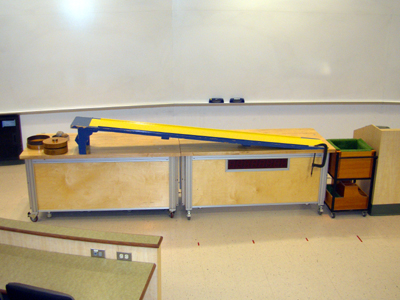
Abstract:
A ring, disc, sphere, and weighted discs of the same diameter are rolled down an incline. Each object reaches the bottom at different times due to differing moments of inertia.
Equipment |
Location |
ID Number |
|
|
|
Cart w/ Ring, Disc, & Sphere |
|
|
Inclined Plane |
|
|
Ring, Disc, & Sphere Extras |
ME, Bay B9, Shelf #3 or in Cart |
|
Table DMM-Timer |
|
Important Setup Notes:
- N/A
Setup and Procedure:
- Unload the ring, disc, and spheres from the cart.
- Position the cart at the stage right end of the lecture bench so that it is touching the bench (see pictures).
- Place the ramp on top of the lecture bench so that it is in line with the cart and such that the bottom edge of the ramp is within about 2 inches of the cart.
- Secure the bottom of the ramp to the bench using the C-clamp provided in the cart.
- Use the provided weights to hold down the top end of the bench (see pictures).
Either roll each object down individually or in pairs to directly compare descent times. A stop watch can be used to quantitatively measure the times.
Cautions, Warnings, or Safety Concerns:
- N/A
Discussion:
For a system of N particles, the moment of inertia can be defined as I = Σimi*ri2 where i ranges from 1 to N. This is important when considering the rotational dynamics of a system. In our case, we are dealing with rigid bodies and can consider the mass distribution to be continuous and uniform in each object consisting of one material. In this case we can replace the discrete sum with an integral over the volume of the object: I = ρ*∫ r2 dV. This quantity is analogous to mass in translational motion. In our case, the moments of inertia for these three objects are
Hoop: I = M*R2
Disc: I = (1/2)*M*R2
Sphere: I = (2/5)*M*R2
where M is the total mass, R is the radius, and the axes of rotation for the hoop and disc is taken to be the axis of rotational symmetry. Each object begins to roll down the ramp (i.e. attains an angular acceleration) because there is a net torque on the objects, the acceleration being determined by α = τnet/I. This shows us that the greater the moment of inertia of an object, the smaller its angular acceleration will be. This is why each object reaches the bottom of the ramp at different times.
|
|
|
|
|
|
|
|
|
|
|
|
|
|
|
|
|
|
|
|
|
|
|
|
|
|
Videos:
References:
